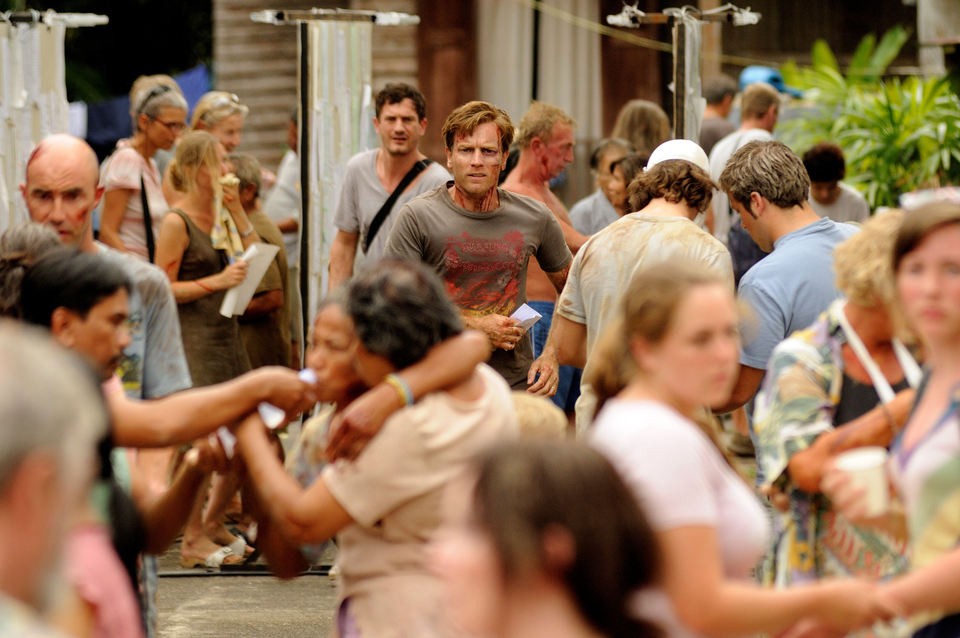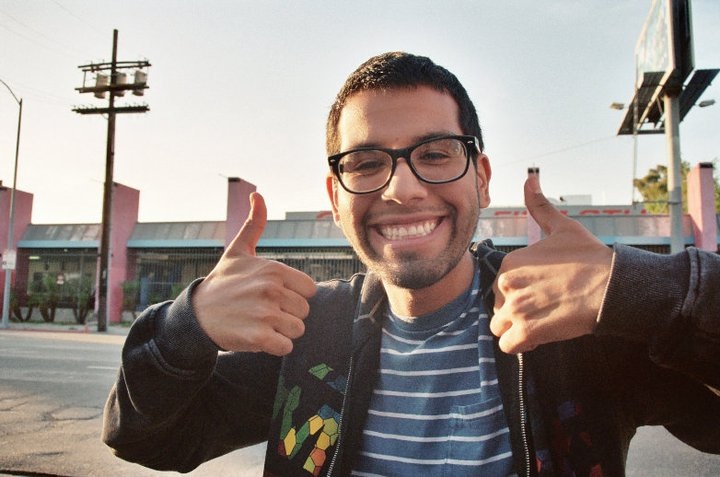The Impossible – Or How I Learned Thailand Was Filled with European Tourists
By Jose Gallegos
Juan Antonio Bayona’s The Impossible (2012) is a curiously constructed disaster film that recounts the heartbreaking journey of the Bennett family as they are separated amidst the confusion in a post-tsunami Thailand. Each family member attempts to reunite with one another, embarking on individual journeys filled with blood, sweat, and tears. In recounting this true account of the Bennetts, Bayona makes some interesting creative decisions by manipulating the melodramatic elements of the family’s separation/reunion. One of Bayona’s more intriguing constructions is his implementation of urban and rural space. Unlike the enclosed and familiar environments of many classic disaster films, such as the airplane in Airport (Dir. Seaton, 1970), the sinking ship in The Poseidon Adventure (Dir. Neame, 1972), and the burning building in The Towering Inferno (Dir. Guillerman, 1974), The Impossible takes place in an exotic landscape that is explored by, and reconfigured for, the white victims/survivors. Though the tsunami erases the divide between urban and rural spaces by creating an exotic wasteland, Bayona’s film reinscribes the destroyed country as a land from which white tourists must be saved. The tsunami may have destroyed the labels of “ethnic space” and “privileged space,” but the film falls back into clichéd formulas that ultimately seem to restore white superiority and, perhaps more importantly, miss important opportunities for social critique.
As previously stated, the story follows the Bennett family – Maria (Naomi Watts), Henry (Ewan McGregor), and their three children, Lucas (Tom Holland), Tomas (Samuel Joslin), and Simon (Oaklee Pendergast) – who come to Thailand for their Christmas vacation. They travel from their home in Japan where Maria works as a physician and Henry as a businessman. Their economic success and higher social status affords them enough money and clout to stay at a luxurious resort. At the resort regional ethnic identity is largely effaced, as workers appear dressed in uniform. A large wall divides white and an “othered” space, keeping the Thai locals separated from the tourist’s privileged areas. During the Bennett’s poolside leisure time, a massive tsunami hits the coast of Thailand, causing massive destruction and separating all the vacationing families (including the Bennetts). The wounded Maria and Lucas find one another while Henry guards Tomas and Simon. The rest of the story focuses on the inevitable reunion, providing narrative closure and catharsis for the audience.

Maria and Lucas cling to debris following the Tsunami
The tsunami, as a narrative trope, is initially subversive as it breaks down the walls between the privileged white resort and the marginalized ethnic Thai city. The two environments merge into an unclassified territory of wreckage and debris, which the privileged Bennetts must explore in order to reunite. Instead of focusing on multiple families in the destroyed territory, Bayona narrows the focus of his film in order to give a face to one particular family who survived the devastating tsunami. However, this creative decision ensures that not only is the face of the surviving family white, but a large majority of the ancillary survivors would be white as well. Additionally, while the construction of racial space appears to shift over the course of the narrative, the film does little to address the larger role that tourism plays, in tandem with the state, in the construction of local ethnic identity as a sort of “prescripted othering” (a point more fully articulated in the work of Robert E. Wood1).
Though there are ample opportunities for the filmmakers to break down and critically engage with the manner by which regional ethnic identity is either made performative (as in state efforts to promote “authenticity” as an element in national tourism marketing strategies) or erased altogether, The Impossible largely evades these questions. Occasionally, Thai characters do play important roles in the story, but their depictions are largely problematic. Many nameless Thai locals aid and save Maria and Lucas, elevating them to the status of “noble natives.” Yet these Thai characters are constantly relegated to the background due to language barriers and the narrative trajectory. Though there are likely marketing and narrative reasons that the scriptwriters chose to limit the development of these characters, this is just another opportunity lost. The Thai people, incomprehensible to Maria and Lucas, take them to the hospital where the rest of the film will take place. While there, Maria encourages Lucas to help the other survivors reunite with their families. Lucas helps a majority of white European tourists (who speak neither English nor Thai) by compiling lists of the victims’ lost family members. Though Lucas appears to be embarking on a colorblind endeavor, his selfless actions truly restore white superiority and white privilege within the hospital space. Their high class and social statuses afford the white tourists the use of the health care facilities, whereas the Thai citizens are still relegated to the devastated city. While the socio-economic element of this scenario seems to make sense, and is another lost site of critique, the reality of South Asian tourism is that an ever-increasing number of international tourists are actually from other Asian countries (particularly Japan).2 As a result, the film shows the tsunami as having destroyed the walls of privilege, but familial reunions help to reorient privilege back into white hands.

Nameless Thai locals aid Maria in the aftermath
Though my argument may appear facile and reductive of instances in which Thai characters do play prominent roles, the reality is that majority of the film focuses on the divisions between white space and ethnic space. Nowhere is this more evident than the tearful reunion of the Bennetts. As a result of Henry contacting his parents and in-laws, the Bennett’s insurance company arranges for a plane to take them away from the wreckage. Maria, Henry, and their children are boarded on the plane, while a gate closes behind them. The gate fences off the faceless masses of Thai people who are not afforded the same ability to escape the landscape. The Bennett’s reunion reconstructs the walls of the resort, which again create a constant divide between the poor Thai people and the wealthy European tourists.

Henry navigating the crowd of survivors
The plane ride home provides an interesting note of closure as the Bennett family look at the names of white survivors that they attempted to help: Lucas has a piece of paper that lists the names of separated family members in the hospital; Henry has the names of the German family members that he was trying to reunite; and Maria has the name of the woman she met in surgery. The three Bennetts examine these names, insinuating that Maria, Henry, and Lucas still need to help others in the destroyed city. Their thoughts are admirable, but still endorse that the white tourists need to be saved from the wreckage. The Bennetts escaped, but there are still multitudes of white victims that remain trapped.
To add insult to injury, the credits of the film reveal that the Bennetts were the Spanish Bélon family, composed of Maria, Enrique, Lucas, Tomás, and Simón. Rather than keeping to the real events upon which the film is based, the Spanish-speaking family is Anglicized into British tourists. According to Bayona, the reasons for this switch were largely financial in that they had some difficulty finding funding unless they used an international cast.3 The emotional punch that the film packs is derived from the main characters appeal as a British family whose social status not only allows them enough money to take a Thai vacation, but also affords them a happy ending via their reunion and plane ride home. Though Bayona’s intentions were to show one family’s struggle, his film causes more problems than it attempts to resolve. During an interview with El Mundo, Bayona went so far as to say that The Impossible “is not a film of nationality, race or social class. All that was swept by the wave.”4 While a nice sentiment, a film that is so wholly tied up in issues of race and class must invariably be viewed as such. In the end, The Impossible is a destructively manipulative film that, in attempting to tell a personal story of survival, reveals an underlying agenda that intends to save the privileged white tourists, while destroying the lives and land of the Thai people.
NOTES
- Robert E. Wood, Ed. Michel Picard, “Tourism and the State: Ethnic Options and Constructions of Otherness,” Tourism, Ethnicity, and the State in Asian Pacific Societies (Honolulu, HI: University of Hawai’i Press, 1997), pp.1-34.
- Ibid., p.3.
- Zuania Ramos, “’The Impossible’ Spanish Cast: The Real Reason Why Film Inspired By Spaniards’ Tragedy Didn’t Use Hispanic Actors,” Huffington Post (14 January 2013).
- Ibid.

The Impossible – Or How I Learned Thailand Was Filled with European Tourists is licensed under a Creative Commons Attribution 3.0 Unported License.

